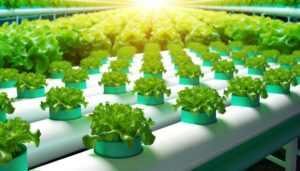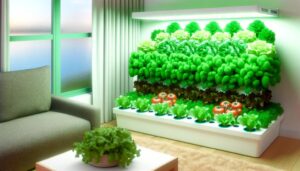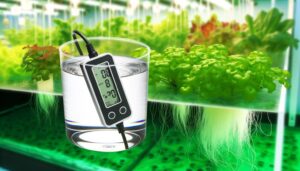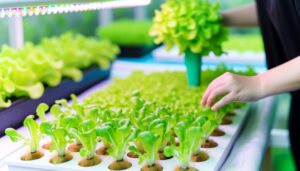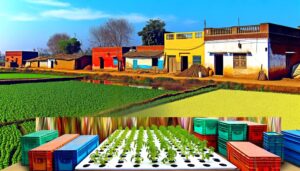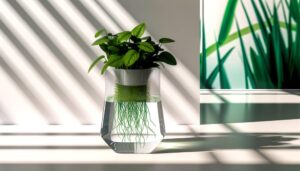The Hydroponic Garden Secret by Susan Patterson
Susan Patterson's 'The Hydroponic Garden Secret' elucidates the principles of hydroponics, a method of growing plants without soil using nutrient-rich water. It covers essential techniques such as nutrient film technique (NFT), deep water culture (DWC), and aeroponics, providing precise control over nutrients and pH levels.
The book highlights benefits like water efficiency and accelerated plant growth, and provides practical advice on choosing suitable plants, managing nutrient solutions, and maintaining ideal conditions. Patterson offers innovative design ideas and sustainable practices, making it a thorough guide for enthusiasts.
Exploring these facets can transform your approach to modern gardening.
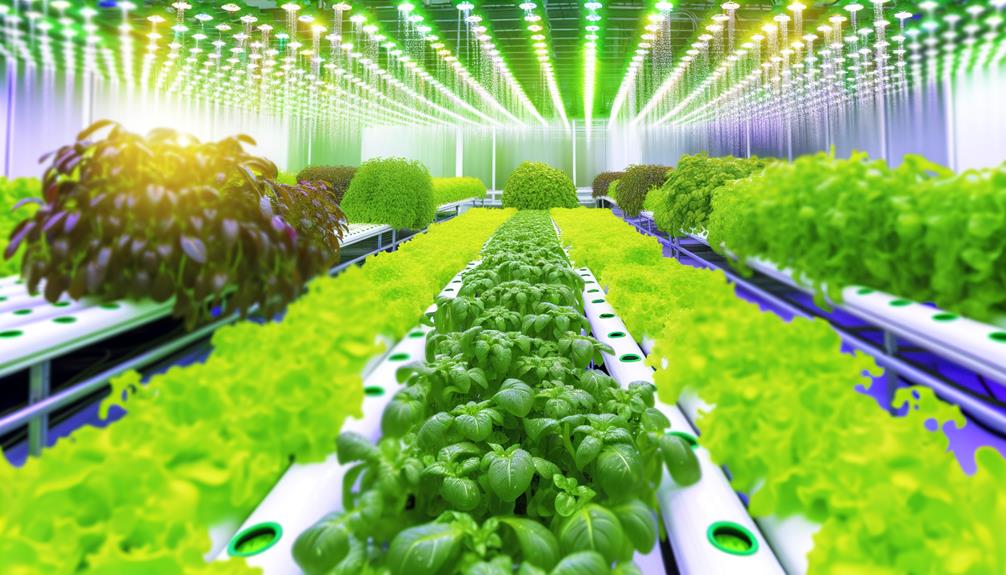
Key Takeaways
- "The Hydroponic Garden Secret" explores hydroponic techniques for growing plants without soil.
- The book emphasizes water efficiency and reduced usage by up to 90%.
- It highlights the benefits of faster plant growth cycles and improved yields.
- Essential equipment like grow lights, nutrient reservoirs, and pH meters are discussed.
Understanding Hydroponics

Hydroponics is a method of growing plants without soil, utilizing mineral nutrient solutions in an aqueous solvent to facilitate plant growth.
This innovative approach involves suspending plant roots in a nutrient-rich water solution, which provides essential minerals directly to the plants.
The system can be managed through various techniques such as nutrient film technique (NFT), deep water culture (DWC), and aeroponics. Each method optimizes oxygen and nutrient uptake, promoting accelerated growth and enhanced productivity.
Hydroponic systems can be precisely controlled, allowing for customized nutrient delivery and pH balancing.
This soil-free cultivation is particularly advantageous in urban settings and regions with poor soil quality, offering a sustainable, space-efficient alternative for producing high-quality crops year-round.
Benefits of Hydroponic Gardening
Hydroponic gardening offers significant advantages, particularly in water efficiency and accelerated plant growth.
Utilizing a controlled nutrient solution, hydroponics can reduce water usage by up to 90% compared to traditional soil-based methods.
Additionally, plants often exhibit faster growth rates due to optimized nutrient delivery and environmental conditions.
Water Efficiency
Utilizing a closed-loop system, hydroponic gardening greatly reduces water consumption by recirculating nutrient solutions, leading to a more sustainable and efficient method of cultivation. This system markedly diminishes water wastage compared to traditional soil-based methods, where a considerable amount of water is lost through evaporation and runoff. In hydroponics, plants absorb only the necessary amount of water, and the excess is captured and reused, promoting water conservation. The efficiency of this method not only supports resource sustainability but also guarantees ideal plant hydration.
| Feature | Traditional Methods | Hydroponic Systems |
|---|---|---|
| Water Usage | High | Low |
| Evaporation Loss | Considerable | Minimal |
| Resource Sustainability | Limited | Enhanced |
This innovative approach aligns with modern agricultural needs for efficiency and environmental stewardship.
Faster Plant Growth
Building on the water efficiency of hydroponic systems, another significant advantage is the accelerated growth rate of plants, attributed to the ideal delivery of nutrients and controlled environmental conditions.
In hydroponic gardening, plants receive a precision blend of nutrients directly to their root systems, minimizing energy expenditure on root expansion and maximizing vegetative growth. The absence of soil-borne pathogens further reduces stress factors, enabling uninterrupted development.
Additionally, controlled light, temperature, and humidity levels create an excellent microclimate, enhancing photosynthetic efficiency.
Studies have shown that hydroponic plants can mature up to 50% faster than those grown in soil. This expedited growth cycle not only increases yield but also allows for multiple harvests within a single growing season.
Essential Equipment
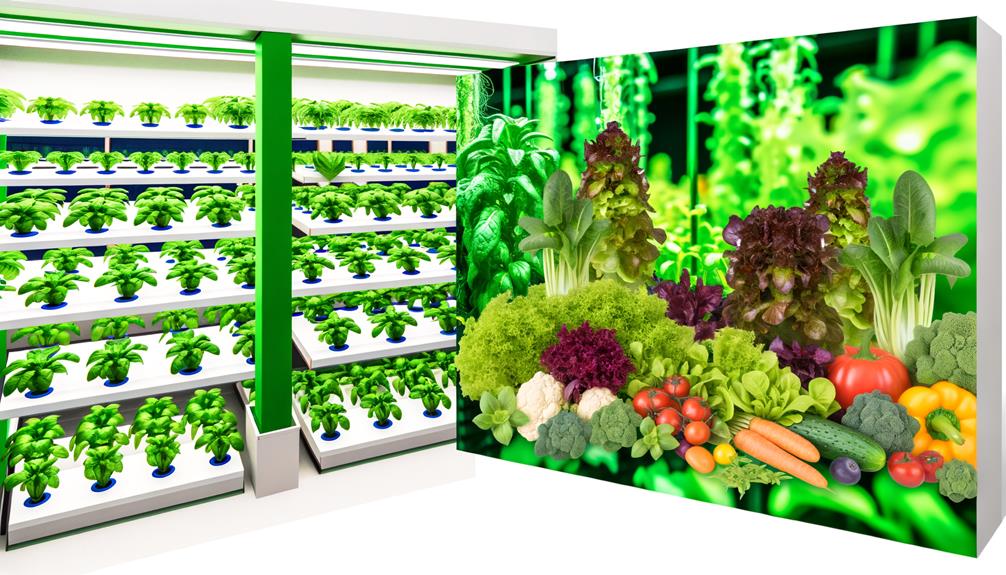
A successful hydroponic garden requires a well-curated set of essential equipment to guarantee ideal plant growth and system efficiency.
Key components include grow lights, such as LED or fluorescent, which provide the necessary light spectrum for photosynthesis.
Nutrient reservoirs and pumps guarantee a steady supply of nutrient-rich water to plant roots.
pH and EC meters are indispensable for monitoring and adjusting water chemistry to best levels.
Air stones and air pumps aerate the nutrient solution, promoting root health.
Net pots and growing mediums like rock wool or clay pellets support plant stability.
Finally, timers automate lighting and feeding schedules, guaranteeing consistency.
This foundational equipment is integral to establishing a robust and productive hydroponic system.
Choosing the Right Plants
Selecting the appropriate plants for hydroponic cultivation is essential for ideal growth and yield.
Beginners should consider species known for their robust growth rates and adaptability, such as lettuce, herbs, and certain varieties of tomatoes.
Additionally, understanding the specific climate and light requirements of each plant will guarantee that environmental conditions are tailored to promote healthy development and maximize productivity.
Best Plants for Beginners
For beginner hydroponic gardeners, selecting plant species that are resilient and require minimal maintenance is essential for ensuring early success and confidence in the gardening process.
Ideal choices include:
- Lettuce (Lactuca sativa): Thrives in hydroponic systems due to its shallow root system and rapid growth cycle. It adapts well to various nutrient solutions, making it a low-maintenance option.
- Basil (Ocimum basilicum): Known for its robustness, basil flourishes in hydroponic environments. It requires minimal attention and provides a steady harvest.
- Spinach (Spinacia oleracea): This leafy green is particularly suitable for beginners as it grows quickly and withstands variable pH levels, ensuring a forgiving experience for novice gardeners.
Starting with these plants can foster a productive and educational hydroponic gardening journey.
Yield and Growth Rates
Understanding the yield and growth rates of various plants is essential for optimizing the efficiency and productivity of your hydroponic system.
Selecting species with rapid growth cycles, such as lettuce and spinach, allows for multiple harvests within shorter periods. Conversely, fruiting plants like tomatoes and peppers, while slower to mature, can yield substantial produce over extended cycles.
Analyzing the specific nutrient and space requirements for each plant type is vital; leafy greens typically demand less space and nutrients compared to fruiting plants.
Implementing crop rotation strategies and staggered planting schedules can further enhance yield consistency.
Climate and Light Needs
When establishing a hydroponic garden, thoroughly evaluating the climate and light requirements of each plant species is essential for guaranteeing ideal growth and productivity. Different plants have distinct needs regarding temperature, humidity, and light intensity.
To optimize your hydroponic system, consider the following:
- Temperature Requirements: Most leafy greens thrive in temperatures between 65-75°F, whereas fruiting plants like tomatoes prefer 70-85°F.
- Light Intensity: Utilize full-spectrum LED lights to mimic natural sunlight, adjusting the intensity based on plant type—lettuce needs less light than peppers.
- Humidity Levels: Maintain relative humidity between 40-70% to prevent mold and guarantee proper transpiration.
Adhering to these parameters will greatly impact plant health and yield, leveraging hydroponics' potential for innovative agriculture.
Nutrient Solutions
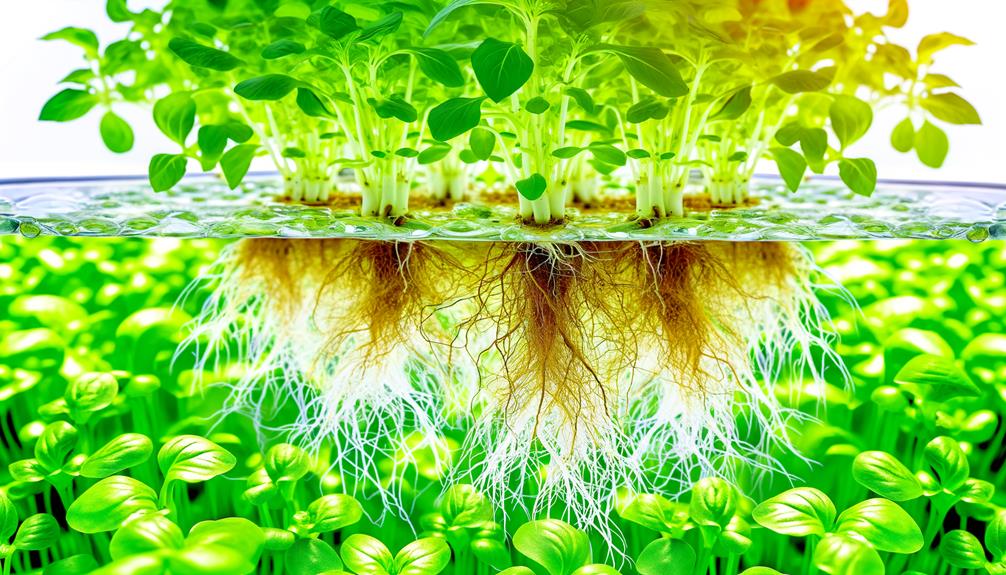
A well-balanced nutrient solution is the cornerstone of successful hydroponic gardening, providing essential minerals and elements directly to the plant roots for ideal growth and yield. Hydroponic nutrient solutions must contain a precise mix of macro and micronutrients to foster peak plant health. The primary macronutrients include nitrogen (N), phosphorus (P), and potassium (K), while secondary nutrients such as calcium (Ca), magnesium (Mg), and sulfur (S) are also essential. Micronutrients, though required in smaller quantities, play a critical role in plant development.
| Nutrient | Function | Deficiency Symptoms |
|---|---|---|
| Nitrogen (N) | Crucial for leaf growth | Yellowing leaves |
| Phosphorus (P) | Root development | Stunted growth |
| Potassium (K) | Flower and fruit production | Brown leaf edges |
| Calcium (Ca) | Cell wall structure | Blossom-end rot |
A tailored nutrient solution guarantees plants receive what they need at different growth stages.
Setting Up Your System
To set up your hydroponic system effectively, it is imperative to begin by selecting a suitable type of hydroponic setup that aligns with your space, crop requirements, and technical capabilities. The following points will guide you through the initial steps:
- Choose a System: Decide between systems like Deep Water Culture, Nutrient Film Technique, or Aeroponics, each offering unique benefits for different crops.
- Lighting: Implement LED grow lights, providing the full spectrum of light necessary for photosynthesis in an indoor environment.
- Water Quality: Guarantee a consistent supply of purified water, free from contaminants, to optimize nutrient absorption and plant health.
Each step is critical for creating an environment conducive to robust plant growth and maximizing yield potential.
Maintenance Tips
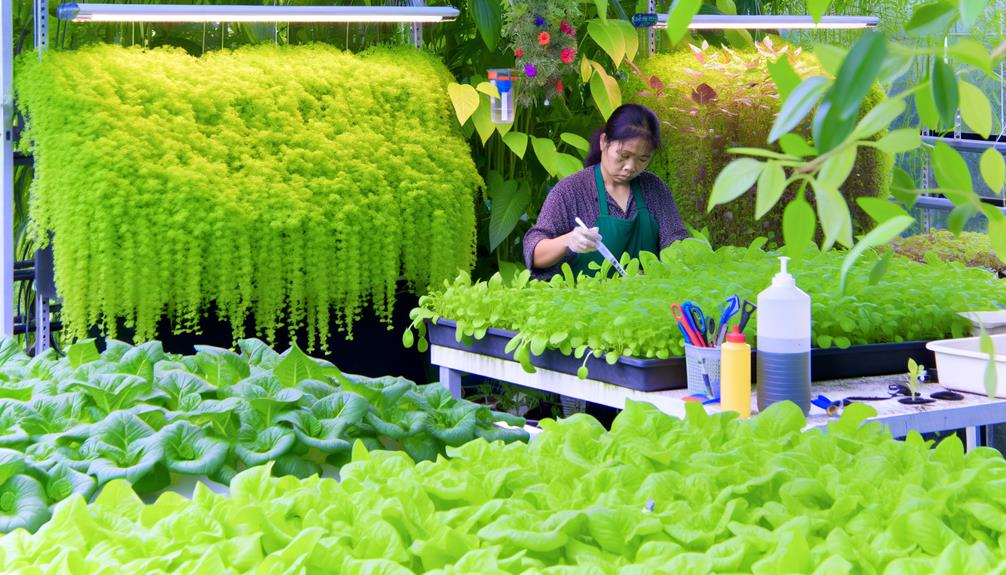
Maintaining a hydroponic system with precision involves monitoring key variables such as pH levels, nutrient concentration, and environmental conditions to guarantee ideal plant health and productivity.
Regularly check the pH levels, aiming for a range of 5.5-6.5, as imbalances can impede nutrient absorption. Utilize a reliable pH meter for accuracy.
Nutrient solutions should be refreshed every two weeks to prevent salt buildup and assure maximum availability of essential minerals.
Environmental conditions, including temperature and humidity, must be controlled; ideal temperatures range between 65-75°F. Additionally, assure adequate aeration to prevent root rot and promote healthy growth.
Consistent monitoring and fine-tuning of these parameters will lead to a thriving, high-yield hydroponic garden.
Troubleshooting Common Issues
Addressing common issues in hydroponic gardening is vital for maintaining plant health and productivity.
Nutrient deficiencies can manifest through specific symptoms such as chlorosis or stunted growth, necessitating precise adjustments in the nutrient solution.
Additionally, implementing effective pest control methods, including biological agents and regular system inspections, is essential to prevent infestations that can compromise your garden's integrity.
Nutrient Deficiency Signs
Identifying nutrient deficiency signs in a hydroponic garden requires a keen observation of plant symptoms such as chlorosis, necrosis, and stunted growth, which can indicate underlying imbalances in essential minerals.
A detailed understanding of these symptoms enables timely and precise corrective actions. Key deficiency signs include:
- Chlorosis: Yellowing of leaves often signals a nitrogen deficiency, fundamental for photosynthesis.
- Necrosis: Dead patches on leaves can indicate potassium deficiency, affecting water regulation and enzyme activation.
- Stunted Growth: Poor overall growth may stem from phosphorus deficiency, crucial for energy transfer and root development.
These signs are essential for maintaining ideal plant health and ensuring a thriving hydroponic system.
Identifying and addressing these deficiencies promptly fosters innovative and sustainable gardening practices.
Pest Control Methods
While managing nutrient deficiencies is essential for plant health, equally important is implementing effective pest control methods to safeguard your hydroponic garden from common pests such as aphids, spider mites, and whiteflies. Utilizing integrated pest management (IPM) strategies, such as biological control and organic insecticides, guarantees minimal disruption to the hydroponic system. Regular monitoring and early detection are crucial for maintaining plant vigor and preventing pest proliferation.
| Pest Type | Control Method |
|---|---|
| Aphids | Introduce ladybugs |
| Spider Mites | Apply neem oil |
| Whiteflies | Utilize yellow sticky traps |
| Thrips | Introduce predatory mites |
| Fungus Gnats | Use Bacillus thuringiensis (Bt) |
Implementing these targeted approaches not only protects plants but also fosters a sustainable and innovative gardening environment.
Creative Design Ideas
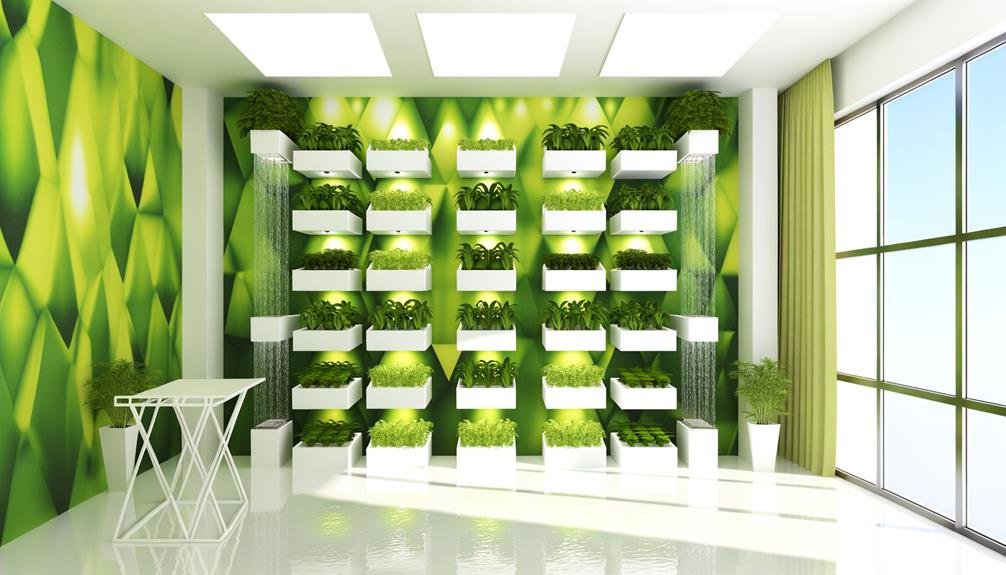
Incorporating vertical farming structures, such as tiered shelves or wall-mounted planters, can maximize space efficiency and optimize light exposure in a hydroponic garden. These innovative designs not only enhance spatial utilization but also facilitate better plant health and growth.
To inspire your hydroponic garden setup, consider the following creative ideas:
- Rotating Vertical Towers: These allow for 360-degree light exposure, promoting uniform growth and reducing shadowing.
- Modular Stackable Units: Adaptable and customizable, these units can be expanded as your garden grows, offering flexibility and scalability.
- Aquaponics Integration: Combining hydroponics with aquaponics creates a symbiotic environment where fish waste provides nutrients for plants, enhancing sustainability and reducing waste.
Implementing these ideas can lead to a more efficient and productive hydroponic system.
Sustainable Practices
Maximizing space and light exposure through creative design ideas is a significant first step, but ensuring the long-term viability of your hydroponic garden requires integrating sustainable practices.
Implementing closed-loop systems for water and nutrient recycling minimizes waste and conserves resources. Opt for organic nutrient solutions and biodegradable growth mediums to reduce environmental impact.
Additionally, harness renewable energy sources, such as solar panels, to power your hydroponic setup, promoting energy efficiency. Regularly monitor and adjust pH levels and electrical conductivity to optimize plant health and resource use.
Conclusion
Hydroponic gardening, akin to a well-orchestrated symphony, harmonizes technology and nature to produce bountiful yields.
Mastery of essential equipment, nutrient solutions, and plant selection, coupled with diligent maintenance and troubleshooting, guarantees a thriving system.
Creative design and sustainable practices further enhance the garden's efficacy.
By understanding the principles and intricacies of hydroponics, one can cultivate a productive and environmentally friendly garden, contributing to a sustainable future in agriculture.

